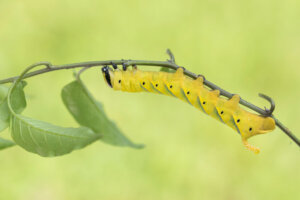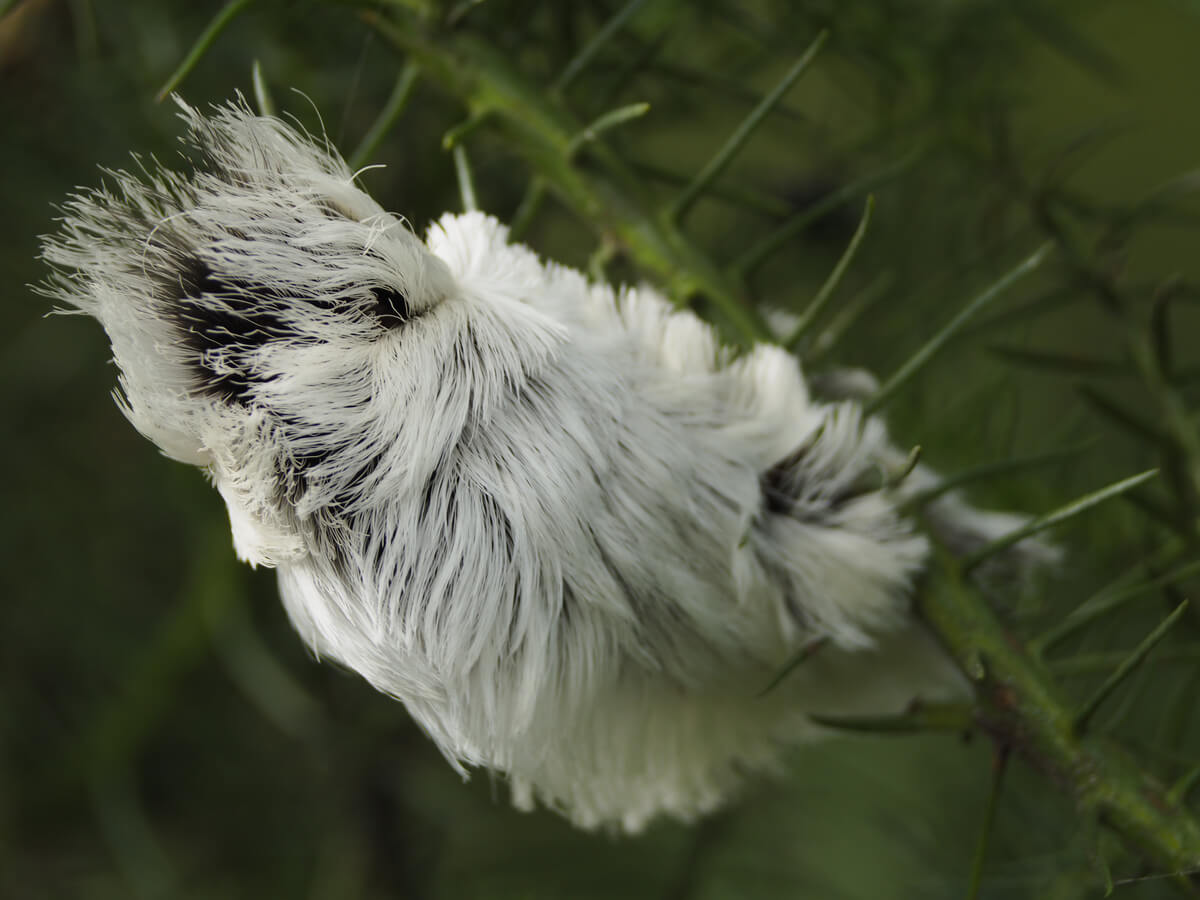The Strange Virus that Turns Caterpillars into Zombies

Bet that title caught your attention! A virus that turns caterpillars into zombies seems like the prologue of a science fiction novel, but, once again, nature has shown us that it has no limits!
Although this zombification process doesn’t consist of reanimating the corpse of a caterpillar, it does involve a modification of its genome and its basic impulses. Curious? Keep reading and we’ll tell you how this virus turns caterpillars into zombies!
Caterpillars
First of all, the most important thing is to characterize the two species involved in this interaction. The insect host of the virus that turns caterpillars into zombies is Helicoverpa armigera, also known as the codling moth, cabbage caterpillar, tomato caterpillar, or Old World caterpillar.
This is a lepidopteran species widespread in southern and central Europe, as well as in temperate Asia, and parts of Brazil. They tend to feed on a wide variety of plants, many of them cultivated.
It’s affected by the zombifying virus in its larval stage. If you’re curious, keep reading and we’ll tell you more.

The virus
The virus that infects the caterpillar belongs to the Baculovirus family. In the study published in 2022 that investigated this phenomenon, a nucleopolyhedrovirus (NPV) was used to infect this species.
This virus, according to the main researcher of the article (Xiaoxia Liu, an important Chinese entomologist), could have been evolving with its hosts for 200-300 million years. The result of this evolution is a curious and chilling (to human eyes) way of propagation that you can read about below.
How the virus that turns caterpillars into zombies works
Although we’ve used the word “zombie” to explain this process of baculovirus propagation, the truth is that the modification of the caterpillar’s behavior is due to a sharpening of its senses. In the aforementioned study, Helicoverpa armigera was infected with a virus called HearNPV and the changes in its behavior were noted.
The process is as follows: the baculovirus modifies the genes of the opsins, the light-sensitive proteins contained in the eyes of cabbage caterpillars, making them more active. In addition, it also affected the gene called TRLP, also involved in vision.
The virus improves the phototaxis of the caterpillar, making it perceive light better.
This visual alteration carried out by the virus is reflected in the behavior of the lepidopteran, which climbs the branches looking for light and ends up dying in the heights. In this way, the baculovirus is able to spread through the air more efficiently.
The importance of phototaxia in insects
This process is surprising, not only because of the impact it has on the behavior of the caterpillar, but also because it goes in direct contrast to its normal life cycle. In fact, the caterpillars tend to go underground to create their chrysalis and spend the winter metamorphosing in the cold.
Because of this, the phototaxis of these caterpillars is considered to be negative, i.e., they tend to move away from light. For many insects, light is a source of orientation, warmth and shelter, although this is not the case for the species in question. Therein lies the mystery of the modification of vision that the nucleopolyhedrovirus operates on them.
Cabbage caterpillars aren’t the only ones that are zombified
You may think this process is one of nature’s unique oddities, but the truth is that this propagation technique is more widespread than you might think. In fact, there are several organisms that use it, like the ones below:
- Ophiocordyceps unilateralis: This species of ascomycete fungus infests ants of the Camponotini group, making them climb to the top of a plant, anchor themselves with their mandibles and die. The fungus then emerges from its corpse, which has free rein to disperse through the air.
- Cordyceps: This is another ascomycete fungus that attacks a host and invades its tissues, eventually replacing them. As a curiosity, it’s used to develop drugs that work against the rejection of transplanted organs.
- Nematomorphs: This phylum of parasitoid worms mainly affects different species of grasshoppers and crickets. Once inside its body, it releases a protein that pushes the insect towards humid areas, where it drowns and helps the worm to renew its reproductive cycle.

As you can see, some parasites’ survival strategies are quite extraordinary, even grotesque. Nevertheless, as we continue investigating, we unravel more and more of nature’s mysteries, which often challenge our thoughts and preconceptions about how certain species work.
Bet that title caught your attention! A virus that turns caterpillars into zombies seems like the prologue of a science fiction novel, but, once again, nature has shown us that it has no limits!
Although this zombification process doesn’t consist of reanimating the corpse of a caterpillar, it does involve a modification of its genome and its basic impulses. Curious? Keep reading and we’ll tell you how this virus turns caterpillars into zombies!
Caterpillars
First of all, the most important thing is to characterize the two species involved in this interaction. The insect host of the virus that turns caterpillars into zombies is Helicoverpa armigera, also known as the codling moth, cabbage caterpillar, tomato caterpillar, or Old World caterpillar.
This is a lepidopteran species widespread in southern and central Europe, as well as in temperate Asia, and parts of Brazil. They tend to feed on a wide variety of plants, many of them cultivated.
It’s affected by the zombifying virus in its larval stage. If you’re curious, keep reading and we’ll tell you more.

The virus
The virus that infects the caterpillar belongs to the Baculovirus family. In the study published in 2022 that investigated this phenomenon, a nucleopolyhedrovirus (NPV) was used to infect this species.
This virus, according to the main researcher of the article (Xiaoxia Liu, an important Chinese entomologist), could have been evolving with its hosts for 200-300 million years. The result of this evolution is a curious and chilling (to human eyes) way of propagation that you can read about below.
How the virus that turns caterpillars into zombies works
Although we’ve used the word “zombie” to explain this process of baculovirus propagation, the truth is that the modification of the caterpillar’s behavior is due to a sharpening of its senses. In the aforementioned study, Helicoverpa armigera was infected with a virus called HearNPV and the changes in its behavior were noted.
The process is as follows: the baculovirus modifies the genes of the opsins, the light-sensitive proteins contained in the eyes of cabbage caterpillars, making them more active. In addition, it also affected the gene called TRLP, also involved in vision.
The virus improves the phototaxis of the caterpillar, making it perceive light better.
This visual alteration carried out by the virus is reflected in the behavior of the lepidopteran, which climbs the branches looking for light and ends up dying in the heights. In this way, the baculovirus is able to spread through the air more efficiently.
The importance of phototaxia in insects
This process is surprising, not only because of the impact it has on the behavior of the caterpillar, but also because it goes in direct contrast to its normal life cycle. In fact, the caterpillars tend to go underground to create their chrysalis and spend the winter metamorphosing in the cold.
Because of this, the phototaxis of these caterpillars is considered to be negative, i.e., they tend to move away from light. For many insects, light is a source of orientation, warmth and shelter, although this is not the case for the species in question. Therein lies the mystery of the modification of vision that the nucleopolyhedrovirus operates on them.
Cabbage caterpillars aren’t the only ones that are zombified
You may think this process is one of nature’s unique oddities, but the truth is that this propagation technique is more widespread than you might think. In fact, there are several organisms that use it, like the ones below:
- Ophiocordyceps unilateralis: This species of ascomycete fungus infests ants of the Camponotini group, making them climb to the top of a plant, anchor themselves with their mandibles and die. The fungus then emerges from its corpse, which has free rein to disperse through the air.
- Cordyceps: This is another ascomycete fungus that attacks a host and invades its tissues, eventually replacing them. As a curiosity, it’s used to develop drugs that work against the rejection of transplanted organs.
- Nematomorphs: This phylum of parasitoid worms mainly affects different species of grasshoppers and crickets. Once inside its body, it releases a protein that pushes the insect towards humid areas, where it drowns and helps the worm to renew its reproductive cycle.

As you can see, some parasites’ survival strategies are quite extraordinary, even grotesque. Nevertheless, as we continue investigating, we unravel more and more of nature’s mysteries, which often challenge our thoughts and preconceptions about how certain species work.
All cited sources were thoroughly reviewed by our team to ensure their quality, reliability, currency, and validity. The bibliography of this article was considered reliable and of academic or scientific accuracy.
- Ng, T. B., & Wang, H. X. (2005). Pharmacological actions of Cordyceps, a prized folk medicine. Journal of Pharmacy and Pharmacology, 57(12), 1509-1519.
- Liu, X., Tian, Z., Cai, L., Shen, Z., Michaud, J. P., Zhu, L., … & Liu, X. (2022). Baculoviruses hijack the visual perception of their caterpillar hosts to induce climbing behaviour thus promoting virus dispersal. Molecular ecology, 31(9), 2752-2765.
This text is provided for informational purposes only and does not replace consultation with a professional. If in doubt, consult your specialist.








